There is no doubt that tinted windows make your car look cooler but that is not all.
It also protects your car interior and passengers from harmful UV and IR rays that are the main cause of skin cancer and damage the car interior.
Tinted windows also add privacy to your vehicle so you can leave your valuables inside without the risk of theft.
While there are a lot of benefits of tinting your windows, at the same time there are some serious drawbacks too. Window tints that are too dark can cause visibility and security issues. Window tint laws are there to make everyone safe.
Especially at night times or in states where the sun doesn’t shine bright, darker tints can make your visibility poor which can lead to road accidents and risk the safety of other pedestrians, cyclists, and cars around you.
It also makes the vehicle suspicious hence grabbing more attention from the police. If police and law enforcement authorities can not see the driver in the vehicle they can stop it and search for drugs and narcotics.
The government is serious about safety and has placed some rules to regulate window tinting.
Window tinting laws tell you how dark the tint should be of each window, so it doesn’t affect visibility (day or at night time) and cause any safety and security problems.
Here are some things that you need to know to decode window tint laws across united states.
- Window tint is measured by Visible Light Transmission through windows after the tint is installed. Often as VLT%.
- Front windows are driver’s and passenger windows only. This does not include windshield.
- Rear windows are any windows that are behind the front windows. This does not include back window glass.
- The windshield band is the film that extends down from the top of the windshield.
- The AS1 line is the marking from the windshield glass manufacturer on the top side.

- Reflection of window tint usually refers to the amount of sun light reflecting off of metallic tint film.
- VLT percentages are for Sedan Type vehicles / SUVs. if there is no / then the VLT% is same for both vehicles.
Here is a representation of how VLT% for window tints affect visibility.
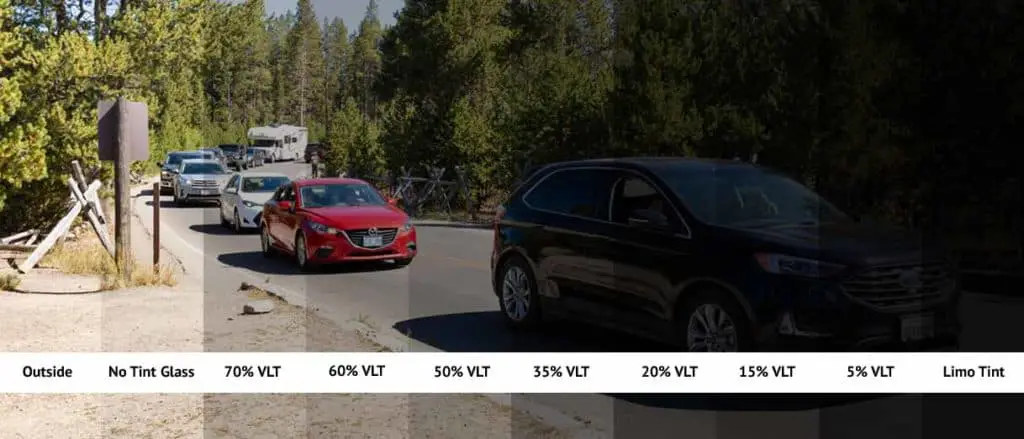
I have made this map with the minimum visible light transmission percentage that is allowed in each state.
In the map below, VLT percentages are shown as Front Windows / Rear Windows.
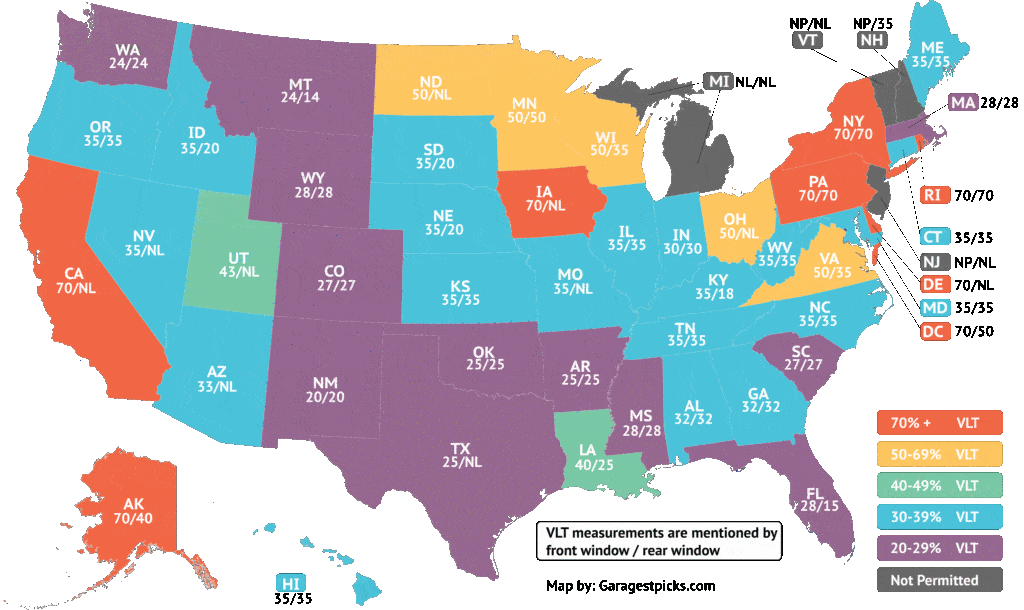
Search in the table below to find the window tint law for how dark you can go in your state.
[table id=2 /]
I have tested a lot of window tint films and found some really good that are worth your money. Do you want to find my top pick? Here is my review.
What is VLT%?
Window tint film comes in different VLT % like 70%, 50%, 35% and more.
Some people often think that the lesser the percentage the less dark the tint would be. But that is WRONG.!
VLT stands for Visible Light Transmission. It is the amount of (total) visible light that is allowed into the cabin after the tint is installed on windows.
Learning about VLT is really simple, the higher the VLT number is, the lighter the tint film and the lower the VLT number, the darker the tint film.
This picture will make it more clear and easy to understand.
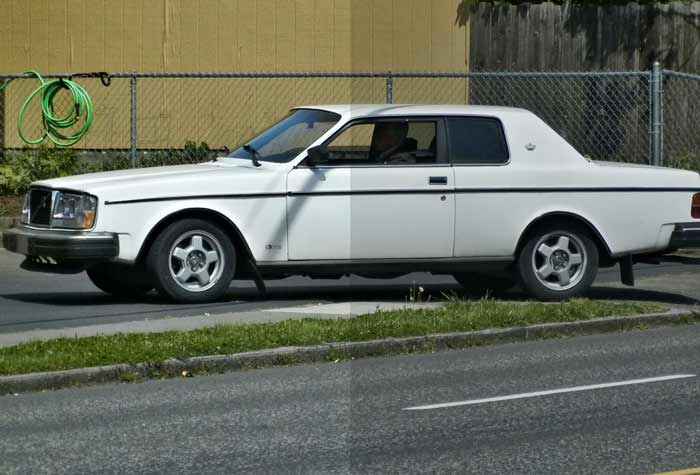
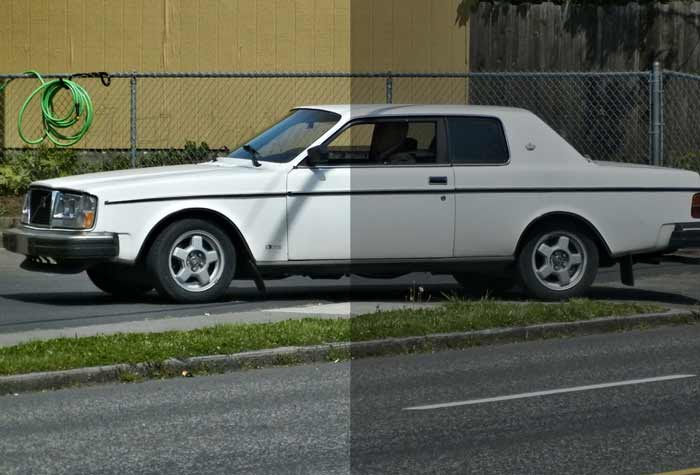
Now, don’t worry about feeling lost because I already covered everything related to car tints in another article. You can check that out if you have learned enough about tint laws! If otherwise, carry on.
Why each state is different?
Each state is different when it comes to weather conditions.
For example, Alabama receives a lot of sun in summers and has very mild winters hence it will be safer with front window tints that allow around 32% visible light on all the windows and a 6-inch tint for visor on windshield.
For the states that won’t see as much sun as New York, your tints (on front windows) are limited to allow 70% visible light and you can’t go darker than that.
Which state is more restrictive?
California is well known for its (extra precautionary) safety laws and window tints are no different.
California has very dry and warm summers and very mild winters but still, you are restricted to tints for front windows that allow at least 70% light inside the cabin.
On the other hand, back windows can go as dark as you would like so passengers on the back seat can have shade and privacy.
Is limo tint “dark black” illegal?
Yes. Dark black tint to the point where you can’t see inside is illegal and will probably cause you to get pulled over. Driving with dark tints on the front windows is like driving with no registration plate.
Why limos are tinted black?
When it comes to limos, the front windows are tinted (or not tinted at all) to allow maximum visible light inside (according to state’s law) to allow law enforcement authorities to know is driving and the passengers are given full privacy and protection from the sun by black tints. This makes them road illegal.
Front windshield tint?
You can put a clear ceramic film that does not affect any visible light transmission, on you whole windshield.
But when it comes to dark tints, you are allowed to put a sun visor tint on the top 4 – 6 inches depending on the state.
This allows maximum visibility at night and don’t risk any security.
What are our benefits in tint laws?
You might say to your self that “who cares?” I’m going to install any tint I like but that is unlawful, unethical and most probably dangerous for everyone on road, including yourself.
Tint laws are there to ensure safety and security on the road for everyone.
Too dark of tints can make it very difficult to identify objects when driving at night and always carry a security threat. Law enforcement authorities need to see inside a vehicle to identify any possible crime or theft.
Vehicles with darker tints that allow only 10% or 5% visible light are more prone to getting pulled over as it is a crime.
Driving with dark tints (or darker then what your state allows) is like driving with no registration plate.
Medical Exemptions and Waivers.
Some states give relaxation on darker window tints for individuals with medical conditions that may suffer from exposure to sun or heat.
Unfortunately, some states do not accept any medical exemptions for any reason.
You have to carry a medical permit, that recommends you darker tints in your vehicle so if you get pulled over you can show it to the officer.
Can you get pulled over for tinting your car windows?
Yes but only if you tint too dark.
If you tint your windows too dark to the point where law enforcement authorities like the police can not see who is inside the vehicle then you are going to get pulled over and searched for illegal weapons and drugs.
Can you get a ticket for tinting too dark?
Yes. Really Dark tints installed on front windows are illegal. If your tints are darker then what the state has allowed, you have violated the state law and will be handed over a ticket.
For the first time, the ticket might be around 150$ for illegal tinting.
If you know your tints are violating law then the easiest way of getting out of a ticket is to peel them off.
How police measure VLT%?
Law enforcement authorities and tint workshops use VLT meter. They mount it on the window to measure visible light inside the cabin, as compared to light present outside and mark your vehicle tints road-legal according to the measurements.
This device uses a laser to take precise measurements.
Can you get jail for failed VLT tests?
No. You can only get a ticket but not go to jail for failed VLT tests. But, if you get caught with illegal drugs and weapons, then you are going to get jail.
Are window tints crime?
No. If your window tints follow state’s law guidelines then you are not committing any crime. But, if your tints are darker than what state has allowed then you might be in trouble.
Sources:
Effects of motor vehicle window tinting on traffic safety.
Effects of automotive window tints on contrast sensitivity.
Use of UV-Protective windows and window films to aid in prevention of skin cancer.

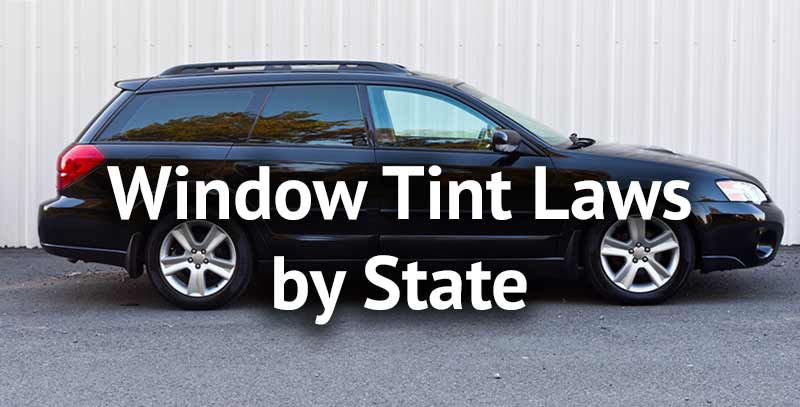
In California is a visor/eyebrow tint also restricted to 70%?
There are no clear rules for eyebrow tint.
I have seen people that have tinted the visor/eyebrow to 30% (or even limo).
All I know is that you are allowed to tint 4 inches and the restricted color is Red. I would suggest you to not go any darker than 30% on the visor/eyebrow.
Limo tint on a visor is not safe when it comes to driving at night. And if you ever get into an accident at night time, your insurance company might find your “super dark” visor tint as a problem.
Hi – great work!!
question – for NY – rear windows you show 70% VLT / no limit. This confuses me. can you explain what this means please? which is it?
thank you
Hey Marc, hope you are doing great!
For NY the tint requirements are 70% VLT / no limit.
This means that the front windows should be tinted with 70%VLT and there is no limit for how dark the tint can be on the rear windows.